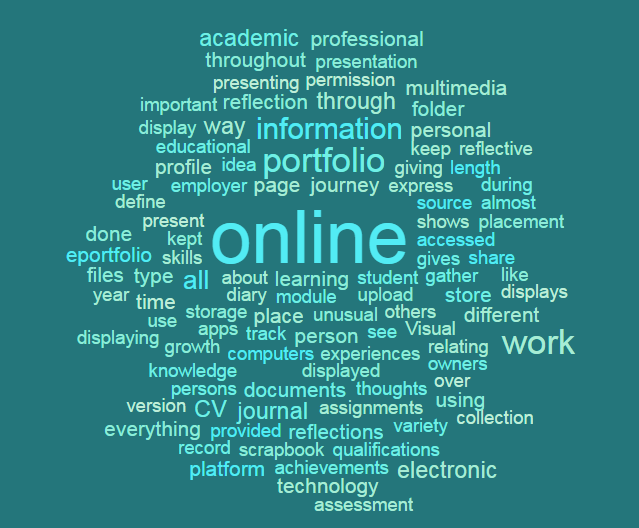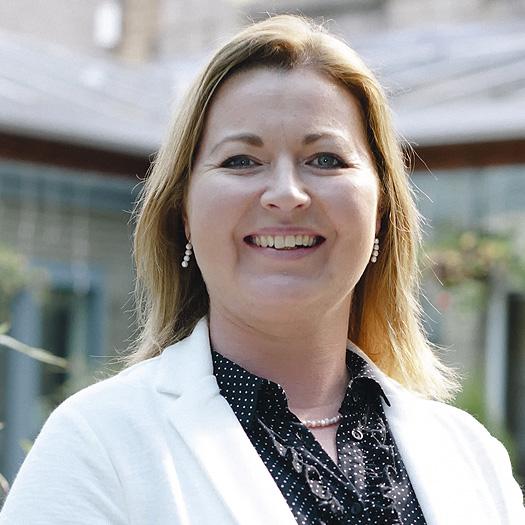
Julie Uí Choistealbha
In this paper, the outcomes of a study designed to explore student’s ePortfolio process and digital competency development in an undergraduate Education Studies degree are presented. The research question “what are students’ perspectives of the benefits and challenges of using ePortfolios?” guides the research. The study is situated in a learning community’s theoretical framework. Data was collected by means of an online student survey and analysed thematically. The main issue emerging from the data is technical ability and students’ desire to have the technical aspects of creating a portfolio deeper embedded into their everyday educational experience. The findings also suggest that students could clearly identify the development of skills, knowledge and competencies when using ePortfolios. However, greater staff student links are required to make their competence development more visible. The paper concludes with a discussion of implications for enhancing the student experience on their undergraduate programme.
Introduction
As part of the Erasmus+ project, Empowering ePortfolio Process (EEP), funded by the European Union, research was carried out in Marino Institute of Education, Dublin, Ireland to find out how students are using ePortfolios and how this usage is contributing to their development of digital competence. These “ePortfolios are student-owned dynamic digital workspaces wherein students can capture their learning and ideas, access their collections of work, reflect on their learning, share it, set goals, seek feedback and showcase their learning and achievements” (Eufolio n.d.).
This study involved the student cohort of the BSc in Education Studies degree programme. The focus of this report is on presenting the findings in terms of student experience of using ePortfolios as part of their degree. Ultimately, the intention of the researcher is to develop the ePortfolio strategy of the programme, in line with the goals of the EEP project, and to contribute to the knowledge base, nationally and internationally, on the highlights and challenges of using ePortfolios with undergraduate education students.
Context
This study is set in the context of the B.Sc. (Bachelor of Science) in Education Studies programme. The B.Sc. in Education Studies is an innovative, professionally-orientated degree programme, which explores education in its broadest sense. Over the course of the 4-year programme, students study adult, adolescent and childhood education as well as various core and optional modules under the four organising pillars of lifelong learning, policy and practice, ethics and social justice and education and culture. Each year, the college-based lectures are complemented by a work placement in an education-related setting in Ireland or abroad. In year 4, students undertake a final year (capstone project) dissertation and an eight-week internship (involving the development of an ePortfolio to demonstrate and reflect on their journey of learning and to make connections with learning across the programme). To date, students have taken work placements/ internships in diverse education settings including Prison Education Services, trade unions, HR departments in multinational companies, Adult Learning Centres, third level access programmes as well as traditional school settings in the early years, primary, post-primary, further education and third level sectors.
Education studies offer students choice, widening their perspective and giving them countless options for future careers and further study routes. Education Studies aims to help students to build networks nationally and internationally, create opportunities, explore new topics and realise their own potential.
The pilot study involves all students completing an ePortfolio, using Mahara, when on work placement. This multimedia portfolio includes a personal dimension (goals, aims, personal statements), a professional dimension (CV, work plan, provider information), an academic dimension (link to modules and readings), a reflective dimension (feedback from WP mentors) and a skill / competency dimension (development of communication, problem solving, leadership/initiative, applied knowledge, teamwork and organisational skills).
Learning communities: A theoretical framework
Lessons from the past have permitted the development of a new education studies learning community whereby “a learning community is any one of a variety of curricular structures that link together several existing courses—or actually restructure the curricular material entirely—so that students have opportunities for deeper understanding of and integration of the material they are learning, and more interaction with one another and their teachers as fellow participants in the learning enterprise” (Gabelnick et al. 1990, 19). The use of the ePortfolio to support students when on placement raises the notion of learning communities. Research on learning communities corroborates the shift in emphasis from learning with the focus on the individual to learning as part of a community. Learning communities can be defined as ‘a group of people sharing and critically interrogating their practice in an on-going, reflective, collaborative, inclusive, learning oriented, growth promoting way’ (Stoll et al. 2006, 223) or an ‘instructional consultation team’ (Rosenfield 1992, 27). Kilpatrick et al. (2003) state that irrespective of the definition used, the common features of learning communities are a common or shared purpose, interests or geography, collaboration, partnership and learning, respecting diversity and enhanced potential and outcomes. The pilot study aimed to increase students’ participation in the learning community centred on their degree programme.
Research design
The research question ‘what are students’ perspectives of the benefits and challenges of using ePortfolios?’ guides the research. Data was collected by means of an online survey using the Survey Monkey application. Both quantitative and qualitative data was gathered in the survey. The sample used was 120 BSc in Education Studies students from first to fourth year. The response rate was 27 percent (n=32). Data was collected from students when they were on work placement – i.e. when they were beginning to utilise the ePortfolio. The data were analysed thematically in line with the survey questions asked in https://www.surveymonkey.com/r/FHGDLWN.
Results
The results are presented under six headings:
- Student data
- Definitions of an ePortfolio
- Competency development
- Benefits and challenges
- Support structures
- Suggestions for development
Data from each area is presented in the following.
Student data
In this section, base data from the student cohort was gathered. As stated above, the data was gathered in advance on portfolios being constructed as part of the pilot study of the EEP programme, In terms of experience of using ePortfolios, 60 percent of students had not used an ePortfolio before and 40 percent were experienced portfolio users. In terms of digital competence, 34 percent of student rated themselves as having a beginner level of digital competence, 63 percent rated themselves as intermediate and three percent declared they were experts in terms of digital competence.
Opinions were also sought from students in relation to their opinions regarding the use of an ePortfolio as a mode of assessment. Of the student cohort 72 percent think that an ePortfolio is a good mode of assessment. The reasons given for ePortfolios being a good mode of assessment include the fact that it is creative, motivating, accessible, appeals to different learning styles; it documents the learning journey and can be kept for future reference. The following quotes from students showcase these positive dimensions of ePortfolios:
It highlights both personal and professional development. It also makes you realise how much you have actually learnt during placement and throughout the BSc course.
An ePortfolio can be displayed through a variety of multimedia and technology mediums for example visual, audio and video aids. By doing so it can showcase information that might have been less explainable if only given in written form. As for assessment, some students find academic writing difficult so by using an ePortfolio they can show off their assignment in a means that they might be more comfortable with. As an aside in organisational workplaces, employees are often required to be competent in technology. An ePortfolio as a learning tool gives students and introduction to technology and allows them to become more familiar with online production of work.
Yes and no. It’s nice to have the freedom to express yourself in different ways but the ePortfolio system (mahara) used in Marino is very restricting with how content can be displayed.
I would be creative and would be more motivated in terms of completing this. I feel having an ePortfolio instead of all written assessment increases my chance in getting a high mark.
Yes, because it is up-to-date on the use of technology. It can be creative, fun and interesting.
All those who thought that the ePortfolio was not a good mode of assessment alluded to the dependency on the technical ability of the student, as the following quotes highlight:
Not everyone likes technology so I think that it is easy for people to get easily frustrated with the process. However, going forward, I think there should be an option as to whether or not a student wants to do an ePortfolio or wants to hand in a hard copy of a portfolio.
I don’t believe it’s a fair mode of assessment as some people are much better at using computers than others so they have a much better chance at getting high grades, I think it involves a lot of work for the people that are not computer wizards.
Definitions of an ePortfolio
Each student provided their own version of a definition of an ePortfolio. The most commonly used descriptor was ‘online’, followed by work, CV, journal, information, academic and professional. Other words used by students to describe ePortfolios are presented in the diagram below:

Competency development
In relation to competency development, students were asked what skills they feel were demanded of them when creating an ePortfolio. Ninety-one percent of students (n= 29) stated that IT skills were necessary for creating an ePortfolio. The next most popular skill listed was creativity (25%, n=8). Other skills mentioned less frequently include: organisation, criticality, patience, time management, innovation, problem solving, adaptability and communication.
You need to be creative and innovative in thinking outside the box of just written forms of communicating knowledge. An aptitude in technology is a big advantage but sometimes developing material for an ePortfolio requires just playing around a bit.
In terms of the skills and competencies developed when compiling an ePortfolio, 34 percent of students said that the work completed on portfolios to date has improved their IT skills, twelve percent referenced an improved creativity and six percent stated that it made them more organised.
My creativity has increased since beginning the ePortfolio as you have to create new ideas on how to present the information
Benefits and challenges
Students were asked to list the benefits and challenges associated with the creation of an ePortfolio. The table below highlights the most common benefits identified by the students:
Table 1. Student perceived benefits of using an ePortfolio.
| Benefit | Percentage | Number |
| Storage of information | 22% | 7 |
| Viewing/ access to information | 22% | 7 |
| Visual representation of information | 9% | 3 |
| Of benefit when contacting a potential employer | 9% | 3 |
| Better to have information available online | 12% | 4 |
| More interesting way of working | 12% | 4 |
| Development of new skills | 9% | 3 |
The following quotes from students illuminate the benefits alluded to in Table 1 above:
It is a more creative form of expressing your knowledge, it is much more interesting for the reader than a long written piece.
You can see all of your work, it is easy to organize and manage, can easily compare and share with others.
An ePortfolio is a diverse way to view knowledge. It is a contemporary way to show one’s aptitude and knowledge development. An ePortfolio allows the developer to use skills they may not have known they possessed.
The table below highlights the most common challenges identified by students:
Table 2. Student perceived challenges of using ePortfolios.
| Challenge | Percentage | Number |
| Technical skills | 47% | 15 |
| Understanding what portfolios are and how to create one | 25% | 8 |
| Availability of samples/ additional support | 12% | 4 |
| Dependence on Wi-Fi | 9% | 3 |
| Time | 9% | 3 |
| Memory capacity of Mahara software | 9% | 3 |
The following quotes from students illuminate the challenges alluded to in Table 2 above:
If you are a beginner like myself it can be overwhelming because it is a completely new concept for me.
Having no previous experience of using an ePortfolio is one of the main challenges as it is a completely new process.
Not everyone is ‘tech-savvy’. Technology can prove difficult for many people to use and often requires to have wifi to do anything with it. I get easily frustrated with the process is my webpage won’t load or I am having difficulty with uploading information onto it.
You have to be good with technology and it can be difficult to rely on wifi and computers as sometimes they fail.
Support structures
In relation to the support services offered by the institute in creating ePortfolios, students felt that although support was available it was not sufficient and the timing of the support was not appropriate. The following quotes show that students want more college-based support structures embedded in the weekly college timetable:
Information classes on the ePortfolio, with reference to the technology aspect. This was provided from the college I just think until you actually start doing the ePortfolio, you nearly have to learn but my doing and having many attempts to upload something correctly for example, a video.
There are youtube videos on the college website offering support when creating ePortfolios. If this idea is to work in a college, classes need to be held on a weekly basis with the year until everyone is fully competent in doing so. It is a very tedious and time consuming process.
Technical support although there are lectures available and organised they are very badly timed and never useful at the time of delivery. Realistically nobody thinks about uploading content until they’ve created the content and are happy with it — at which point the technology sessions are long over.
Suggestions for development
Students provided a number of suggestions for improving the way in which the institute approaches ePortfolios. These suggestions include:
- More detailed and consistent support classes.
More classes and workshops should be in place especially since they are going to be included in our grades. - Earlier introduction of the ePortfolio.
ePortfolios are a great inclusion in 3rd/4th year but earlier introduction (1st & 2nd yr) would help and have you a “pro” by 4th year! - Exploration of different ePortfolio platforms.
Might be better if we could use a different platform i.e. a personal blog — less restrictions, more choice, more creative control in design.
Concluding Discussion
This data gathering exercise has explored the student perspective of the ePortfolio process. It has found that students are in general positively disposed to ePortfolios but that they require more technological support in order to enhance their digital competence. The data has shown that the ePortfolio process utilised to date has been student — dependent with an inadequate teacher guiding process. Overall ePortfolios were perceived to improve the educational environment due to their creativity in particular. A minimal link to the world of work was made although students did allude to well-known workplace skills such as time management, organisation and communication. The ePortfolio process motivated students and they perceived it as a positive, inspiring assessment approach. The main issue emerging from the data is technical ability and students desire to have the technical aspects of creating a portfolio deeper embedded into their everyday educational experience.
In conclusion, the author believes that the future of ePortfolios in the Institute is positive if the following matters are addressed:
- technical support for students
- greater linkage to the world of work
- more teacher-led guidance of the process.
It is envisaged that when these matters are addressed that the ePortfolio process would enhance the totality of the student experience on the Education Studies programme. The report of the Irish Student Survey (2015) shows that student experience of higher education involves academic challenge, active learning, enriching educational experiences and positive relationships with staff. A more balanced approach to the student experience encourages the development of collaborative relations between students and staff (Neary and Winn 2009). York and Longden (2008) found that increased emphasis on active teaching methodologies and increased student choice in the HEI setting lead to a more positive student experience. A cross-institutional commitment to acting on student feedback was found by Browne (2010) to bring about enhanced student experiences as the students felt valued by the HEI and integral to the learning ecology. However, this requires responsibility on behalf of the student to engage positively with the educational experience and the HEI to provide a learning environment that promotes active student participation (Davis & Murrell 1993).

This article was produced in the Erasmus+ (KA2 action) funded project “Empowering Eportfolio Process (EEP)”. The beneficiary in the project is Häme University of Applied Sciences (FI) and the partners are VIA University College (DK), Katholieke Universiteit KU Leuven (BE), University College Leuven-Limburg (BE), Polytechnic Institute of Setúbal (PT) and Marino Institute of Education (IE). The project was implementated during 1.9.2016–30.11.2018.
Author

Julie Uí Choistealbha, PhD (Ed.), works in Marino Institute of Education as Lecturer in education in the School Placement Department, Coordinator of the BSc in Education Studies programme. She teaches on the advanced professional studies module, the second language teaching and learning specialism and works with students in advance of school placement, work placement and internship. Her research interests include work-based learning for students of education, the assessment of work-based learning, the use of ePortfolios in competency-based assessment, the final year curriculum design of a professionally-orientated degree and working in partnership with schools on practicum design. She is a Trinity College Research Fellow in the School of Education’s Research in School Education (RISE) research group.
References
Browne, J. (2010). Securing a sustainable future for higher education: an independent review of higher education funding and student finance. Published report. Retrieved 26 January 2018 from https://www.gov.uk/government/uploads/system/uploads/attachment_data/file/422565/bis-10-1208-securing-sustainable-higher-education-browne-report.pdf
Davis, T. M. & Murrell, P. H. (1993). Turning teaching into learning: the role of student responsibility in the collegiate experience. Washington: ERIC.
Eufolio (n.d.). Retrieved 26 January 2018 from http://eufolio.eu/
Gabelnick, F., MacGregor, J., Matthews, R. S., & Smith, B. L. (eds.) (1990). Learning Communities: Creating Connections Among Students, Faculty, and Disciplines. New Directions for Teaching and Learning, 41. San Francisco: Jossey-Bass.
Irish Survey of Student Engagement. (2015). The Irish Survey of Student Engagement (ISSE), Results from 2015. Published report. Retrieved 26 January 2018 from http://studentsurvey.ie/wp-content/uploads/2015/11/ISSE-Report_2015-final-tagged.pdf
Kilpatrick, S., Barrett, M., & Jones, T. (2003). Defining Learning Communities. CRLRA Discussion Paper Series, Centre of Research and Learning, University of Tasmania. Retrieved 26 January 2018 from https://www.aare.edu.au/data/publications/2003/jon03441.pdf
Neary, M. & Winn, J. (2009). The Student as Producer: Reinventing the Student Experience in Higher Education. In L. Bell., H. Stevenson, & M. Neary (eds.) The Future of Higher Education Policy, Pedagogy and the Student Experience. London: Continuum, 126–138.
Rosenfield, S. (1992). Developing school based consultation teams: A design for organisational change. School Psychology Quarterly, 7(1), 27–46.
Stoll, L., Bola, R., McMahon, A., Wallace, M., & Thomas, S. (2006). Professional Learning Communities: A review of the literature. Journal of Educational Change, 2, 221–258.
Yorke, M. & Longden, B. (2008). The First Year Experience of Higher Education in the UK. York: Higher Education Academy. Retrieved 26 January 2018 from https://www.heacademy.ac.uk/system/files/fyefinalreport_0.pdf





